Ecosystems and Energy Flow
Maharashtra Board-Class-12th-Biology-Chapter-14
Notes
|
Topics to be Learn :
|
Introduction :
An ecosystem is a structural and functional unit of nature that is self-regulating and self-sustaining (biosphere). It is made up of both biotic and abiotic elements.
- Biotic elements interact with the world around them as well as one another.
- Earth ecosystem is divided into two basic categories, viz. terrestrial and aquatic.
- Forest, grassland and desert are the types of terrestrial ecosystems.
- Lakes, wetlands, rivers and estuaries are the types of aquatic ecosystems.
- The ecosystems can also be classified as Natural ecosystems and Artificial ecosystems.
- Natural ecosystems: The ecosystems which operate under natural conditions without any much major interference by man are called natural ecosystems. E.g. terrestrial ecosystems such as grasslands, forests, deserts, etc. or aquatic ecosystems such as lakes, river, wetland, etc.
- Artificial ecosystems The man engineered ecosystems which are maintained artificially by man by the addition of energy are called artificial ecosystems. These ecosystems are dependent upon manipulations from human beings. E.g. croplands, aquarium, aquaculture, etc. are the types of artificial ecosystems.
- Dynamics of ecosystem : Input of ecosystem means productivity, transfer of energy in ecosystem is by a food chain, food web and nutrient cycling and output of ecosystem means degradation and energy loss.
Ecosystem
Structure and function :
- Each type of ecosystem's physical structure is the outcome of the interaction of biotic and abiotic elements.
- Understanding the species composition of an environment requires the identification and recording of the regional plant and animal species.
- Biotic and abiotic components differ as the locations vary in space and time. The variation due to space results in spatial pattern.
- There are two types of spatial patterns. viz. Stratification and Zonation.
(i) Stratification : Stratification is the spatial pattern which occurs vertically. This is determined by the height of organisms. Such stratification is seen in forest community where trees of different species grow to different heights. (ii) Zonation : Horizontal distribution of plants and animals on land or in water, is called zonation. Zonation is the spatial pattern which occurs horizontally along the ground. Along a horizontal gradient, the density and distribution of the species keep on varying,

Subtidal Channels
Mudflats
Low marsh
High marsh
These are important habitat for fish at low tide. They allow good drainage and flooding in Mudflats.
These are rich in invertebrate life for shorebirds. Algal mat grow here also.
This is good habitat for cordgrass, insects, herons and egrets and the clapper rail.
Supports pickleweed and patches of cordgrass. A good habitat for Savannah Sparrow and Clapper Rail
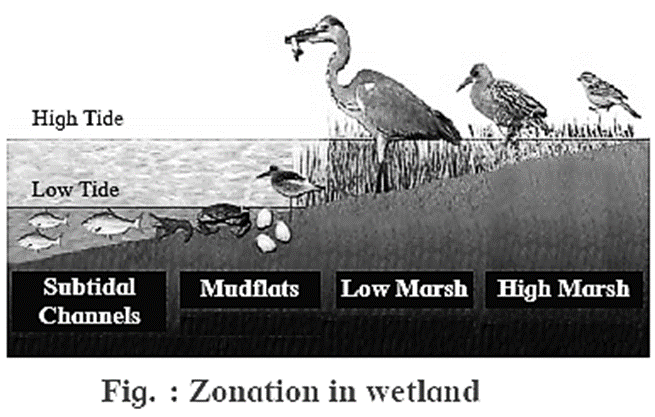
Functional aspects of ecosystem :
The biotic and abiotic components of an ecosystem are all linked together to function as an ‘ecosystem unit’ through various functional aspects of ecosystems.
Productivity, Decomposition, Nutrient cycling and Energy flow are the four functional aspects of any ecosystem.
(i) Productivity :
- Conversion of inorganic substances into organic material using solar energy by the autotrophs is called productivity. Consumption of autotrophs by heterotrophs.
- Solar energy is a must for any ecosystem for sustenance.
- Rate of generation of biomass in an ecosystem expressed as gram/sq. metre/day.
Gross primary productivity (GPP) : Rate of production of organic matter by photosynthesis.
Net primary productivity (NPP) : Net Primary Productivity = Gross primary productivity — respiratory losses. NPP is available biomass which heterotrophs can use.
- Annual NPP of whole biosphere = 170 billion tons dry weight of organic matter.
- Ocean productivity = 55 billion tons.
Factors on which GPP depends :
- Resident plant species
- Availability of nutrients
- Photosynthetic capacity of plants
- Type of ecosystem
Secondary productivity : Rate of formation of new organic matter by consumers. This is available energy which is transferred to next trophic level.
(ii) Decomposition : The important steps in the process of decomposition are fragmentation, leaching, catabolism, humification and mineralization. In decomposition, fragmentation, leaching, catabolism operate simultaneously on the detritus. Humification and mineralization occur during decomposition in the soil. Factors regulating decomposition :
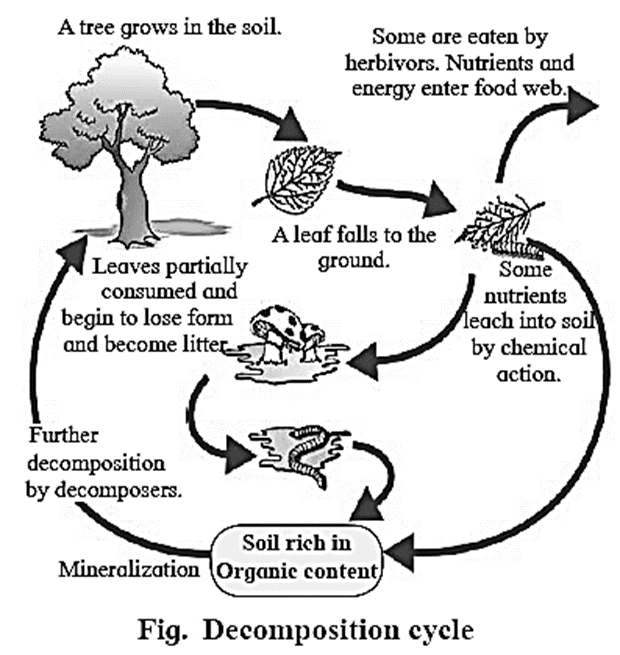
(iii) Nutrient cycling : Storage and transport of nutrients.
(iv) Energy flow : Flow of energy from producer to consumer in unidirectional way. Dissipation and loss of heat during energy flow is inevitable.
Energy flow :
- Except for the deep-sea habitats, the sun is the only source of energy for all terrestrial ecosystems.
- Less than 50% of solar radiation that falls on the earth’s surface is photosynthetically active radiation (PAR). Only 2-10 % of PAR sustains the entire living world.
- Plants and autotrophic bacteria fix solar radiant energy into complex carbohydrates while using simple inorganic materials. Plants thus are the producers that supply the energy in the form of food to consumers.
- There is always unidirectional flow of energy from the sun to autotrophic producers and then to heterotrophic consumers.
- Second Law of thermodynamics operates for the ecosystems too. The universal tendency towards increasing disorderliness is always counteracted by producers and consumers.
- Organisms in the ecosystem need a constant supply of energy to survive and synthesise the required molecules.
- Major primary producers are herbaceous and woody plants in a terrestrial ecosystem. In an aquatic ecosystem primary producers are phytoplankton and algae.
- Food chain/Food web : The chain or web formed due to interdependency among various organisms of the ecosystem is known as food chain.
- Energy that is trapped into an organism keeps on flowing. Producers trap the energy and pass it further to a consumer. If the producer dies, the death of organism starts the detritus food chain/web.
Concept of energy flow : For considering the energy flow in an ecosystem the following aspects have to be taken into account : The energy captured by autotrophs never returns back to the sun. The energy obtained by the herbivores will never go back to autotrophs. Hence energy flow is always unidirectional. The energy flow through different trophic levels is progressive and hence previous trophic level cannot get this back. The amount of energy keeps on decreasing as it travels to further trophic level. This loss of energy is due to dissipation as heat formed during various metabolic activities of the organism. The energy loss is measured as respiration coupled with unutilized energy. If the food chain is shorter there is greater amount of available food energy. When the length of food chain increases, there is corresponding more loss of energy.
Food web :

Consumers : All animals directly or indirectly depend on plants to obtain their food. They cannot synthesise their own food so they are called heterotrophs or consumers.
Primary consumers : Consumers feeding directly on the producers are called primary consumers. For example, Herbivorous animals. Insects, birds and some mammals are herbivores or primary consumers in the terrestrial ecosystem and molluscs are primary consumers in aquatic ecosystem.
Secondary consumers : The animals consuming other animals are secondary consumers. For example, Carnivores. Primary carnivores are secondary consumers
Secondary consumers feed on primary consumers.
Tertiary consumers : Animals feeding on secondary consumers are called tertiary consumers.
- For example, in the food chain “Plant matter -> Insect —> Frog —> Snake", insect is primary consumer, frog is secondary consumer and snake is the tertiary consumer.
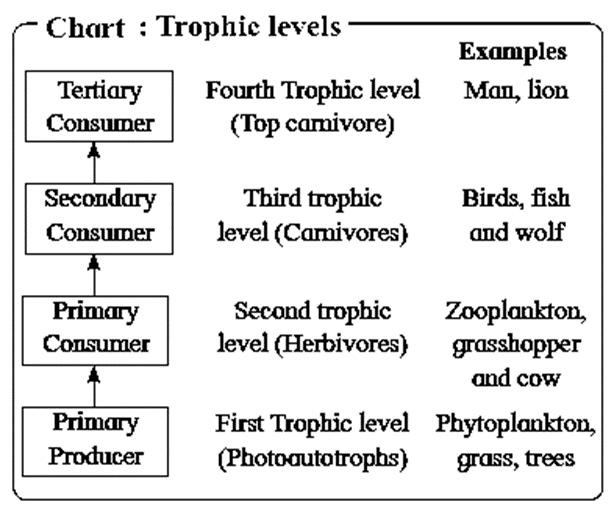
Food chain :
- Food chain is the linear sequence of organisms for feeding purpose.
- In food chain the flow of energy is through a single straight pathway from the lower trophic level to the higher trophic level.
- In a food chain, members present at higher trophic level feeds on only single type of organisms.
- Energy flow can be easily calculated in food chain.
- In food chain there is increased instability due to increasing number of separate and confined food chains.
- The whole food chain gets affected even if one group of an organism is disturbed.
- Member of higher trophic level depends or feed upon the single type of organisms of the lower trophic level.
- Food chain consists of only 4-6 trophic levels of different species.
- Competition is seen in members of same trophic level.
Types of food chains and energy flow :
Food chains are of two types : Grazing food chain and detritus food chain. A simple grazing food chain (GFC) is shown as follows :
- The detritus food chain (DFC) is made up of decomposers. It starts with dead and decaying matter. Examples of decomposers are fungi and bacteria. Decomposers are also called heterotrophic saprotrophs. (sapro : to decompose). By degrading dead organic matter or detritus, decomposers meet their nutritional and energy requirements. Digestive enzymes of saprotrophs breakdown dead and waste materials into simple inorganic materials before their absorption which are subsequently absorbed by them.
- In an aquatic ecosystem energy flow occurs only through grazing food chains whereas in a terrestrial ecosystem, majority of energy flow occurs through the detritus food chain.
- There are interconnections between detritus food chain and grazing food chain at some levels. Some organisms of DFC serve as prey to the GFC animals. Some animals like cockroaches, crows, pig and man, etc. are omnivores.
- The natural interconnection of food chains is called a food web.
- At each successive trophic level, the amount of energy available goes on reducing. The trophic levels in any food chain transfer the energy when it is functional.
- ‘10% Law’ of R. Lindermann, 1942 : The law states that ‘only 10% of the energy is transferred to each trophic level as net energy, from the previous trophic level.
- Food chains are never in isolation, but are always interconnected to form food web for maintaining the stability of an ecosystem.
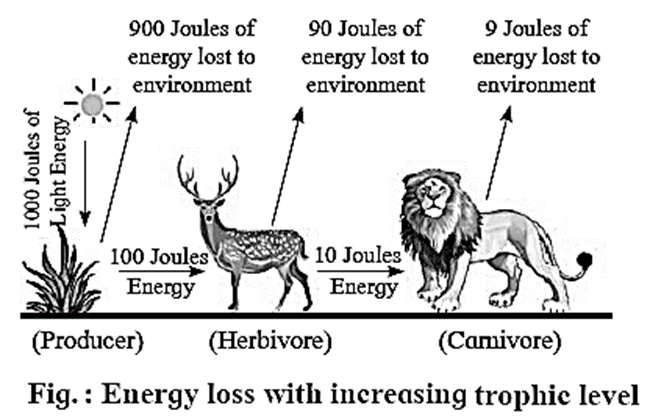
Ecological Pyramids :
- Ecological pyramid is a graphic representation of the relationship between the organisms of various successive trophic levels with respect to energy, biomass and number.
- C. Elton in 1927 developed the concept of ecological pyramids.
- Each pyramid's base corresponds to the producers, or the first trophic level, and its tip to the tertiary, or top level, consumer. Any calculations for biomass, energy content, or population must take into account every organism at that trophic level.
- The Pyramid of Biomass, Pyramid of Numbers, and Pyramid of Energy are the three ecological pyramids that are typically researched.
- The calculations of energy content, biomass or number include all organisms at that trophic level. Some organisms may occupy more than one trophic level simultaneously. e.g. A primary consumer sparrow can become secondary consumer when it feeds on insects.
- The trophic level thus represents a functional level and not a species as such.
- All the pyramids, of number, of energy and biomass are upright in most of the ecosystems. i.e., producers always outnumber the consumers. Similarly biomass is more for producers than that of the herbivores.
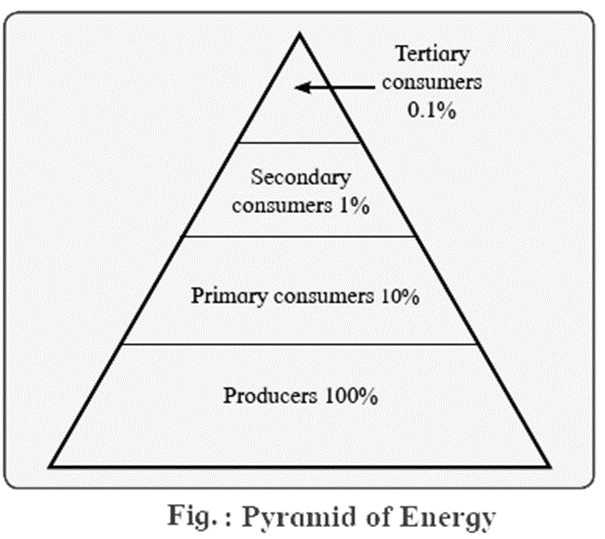
- Herbivores or primary consumers outnumber carnivores. Energy at a higher trophic level is always less than energy at the lower trophic level.
- When energy flows from a lower trophic level to the next trophic level, some energy is always lost as heat at each step. Therefore the pyramid of energy is always upright. It is never inverted. In the energy pyramid, the amount of energy in a given time and per unit area is shown by each bar.
Pyramid of numbers : Pyramid of biomass : Pyramid of biomass are constructed by taking into consideration the different biomass in every successive trophic level.
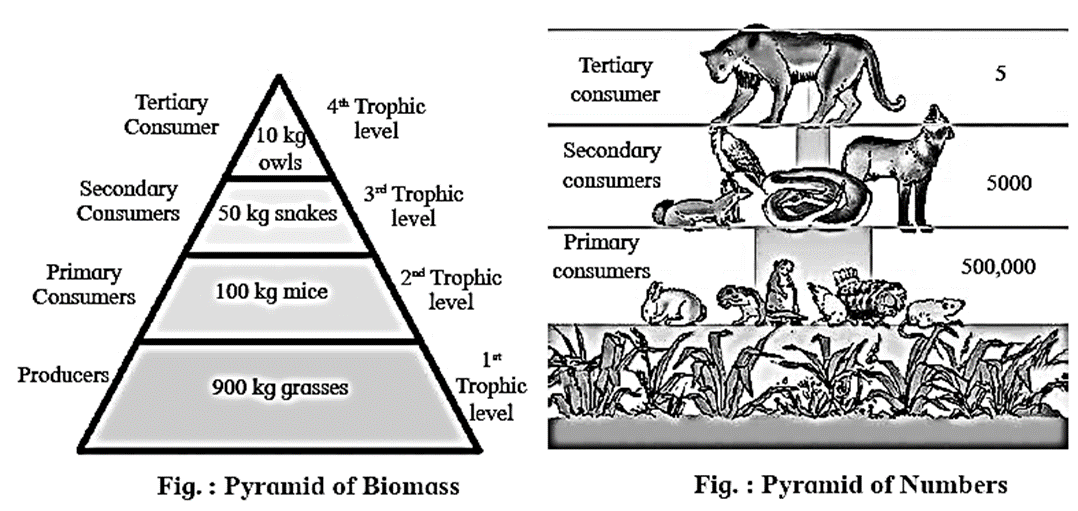
Exceptions to pyramid structure :
- The pyramid of biomass in sea is also generally inverted as the biomass of fishes far exceeds that of phytoplankton.
- Many insects and birds thriving on a single huge tree will also show inverted pyramid of numbers.
Distinguish between Upright and inverted pyramid of biomass :
| Upright pyramid of biomass | Inverted pyramid of biomass |
| 1-In upright pyramid, the number and biomass of the organisms which are at first trophic level of producers is high.
2-The biomass goes on decreasing at each trophic level. 3-The base of the pyramid is always in large number of producers. |
In inverted pyramid, the number and biomass of organisms at first trophic levels of producers is lowest.
The biomass foes on increasing at each trophic level. The base of pyramid is always in small numbers of producers. |
Q. The pyramid of biomass in the sea is inverted. Give reason.
Ans. The food chain in the sea is dependent on producers i.e. phytoplankton. The biomass of phytoplankton is always lesser to the biomass of fishes which are dependent upon these phytoplankton. The pyramid of biomass, therefore, in the sea is inverted.
Limitations of the ecological pyramids :
- Ecological pyramids do not take into account the same species belonging to two or more trophic levels.
- They are based on simple food chain. In nature simple food chains do not exist but all the trophic relationships are in the form of food web.
- Saprophytes play a major and vital role in the ecosystem but they are not shown in ecological pyramids.
Nutrient cycles :
Nutrient cycling : Nutrient cycling or biogeochemical cycle is the movement of nutrient elements through various components of ecosystem.
Two types of nutrient cycles :
- Gaseous (nitrogen, oxygen and carbon) having reservoir in atmosphere.
- Sedimentary (Phosphorus, Sulphur) having Earths crust as reservoir.
Carbon Cycle : (Gaseous cycle) Impact of human activities on carbon cycle :
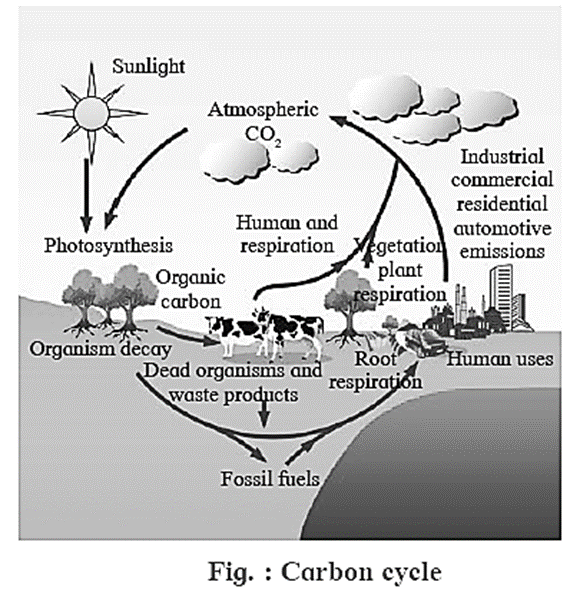
Phosphorus cycle : (Sedimentary cycle)
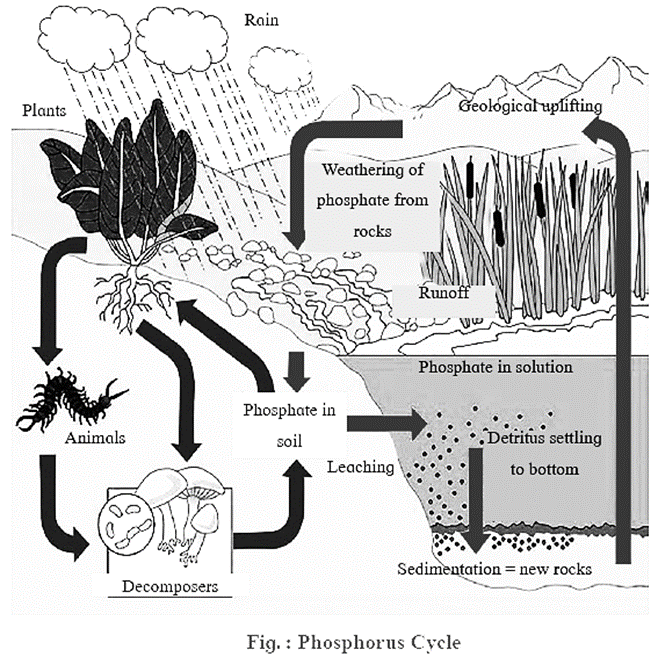
- Phosphorus cyclically moves through hydrosphere, lithosphere and biosphere.
- It is a major constituent of biological membranes, nucleic acids and cellular energy transfer systems.
- Animals require large quantities of phosphorus to make shells, bones, hooves and teeth.
- The natural reservoirs are rocks containing phosphates.
- Weathering of rocks release minute amounts of phosphates in soil solution which is needed by plants.
- Herbivores and other animals get phosphorus through plants.
- Decomposition of waste products and the dead organisms by phosphate-solubilizing bacteria release phosphorus.
- Phosphorus is always in short supply, thus acts as a limiting factor for the plant growth.
- Eutrophication : Eutrophication is the sudden influx of phosphorus in water bodies due to agricultural runoff or industrial effluents Which are rich in phosphate content.
- Eutrophication causes overgrowth of algae which kills or harms the aquatic life
Ecological Succession :
Succession : It is a spatial pattern which occurs over the time. Time is a crucial factor.
Ecological succession :
- Ecological succession refers to the steady and often predictable shift in the species composition of a particular area. It is a long-term response by the community to the environment.
- According to the shifting environmental conditions, all communities constantly modify their composition and organisational structure. Parallel to changes in the physical world, this transformation is ordered and systematic.
Climax community: Community that is in near equilibrium with the environment after the ecological succession. The change is sequential and environmentally regulated in climax community. Process of succession involves following sequential steps : Some populations become more numerous, whereas some populations decline and even disappear during the succession. Newer species also colonise the areas. Nudation : Nudation is disturbance, Succession begins with the development of a bare site. Migration : The tiny seeds or propagules arrive during this phase_ Ecesis : Ecesis is the establishment and initial growth of vegetation. Competition : When vegetation becomes well-formed and established, it grows and competes with other species for space, light and nutrients. Reaction : Autogenic changes such as the build-up of humus affect the habitat, and one plant community replaces another during this phase. Stabilization : The community which is better, becomes stable forming a Climax community.
Know This :
Sere : Sere is the entire sequence of communities that successively change in a given area. Seral stages or seral communities are the individual transitional communities in this sere.
Following changes take place in the successive seral stages :
- Change in the diversity of species of organisms.
- Increase in the number of species and organisms,
- Increase in the total biomass.
Similar succession is said to have taken place in past over millions of years forming the present day global communities. Succession and evolution were the parallel processes in the past and also at the present. .
Succession is of two types, viz. Primary succession and secondary succession. Primary succession : Primary succession means the initial development of life on barren piece of land. Secondary succession :
Succession of Plants :
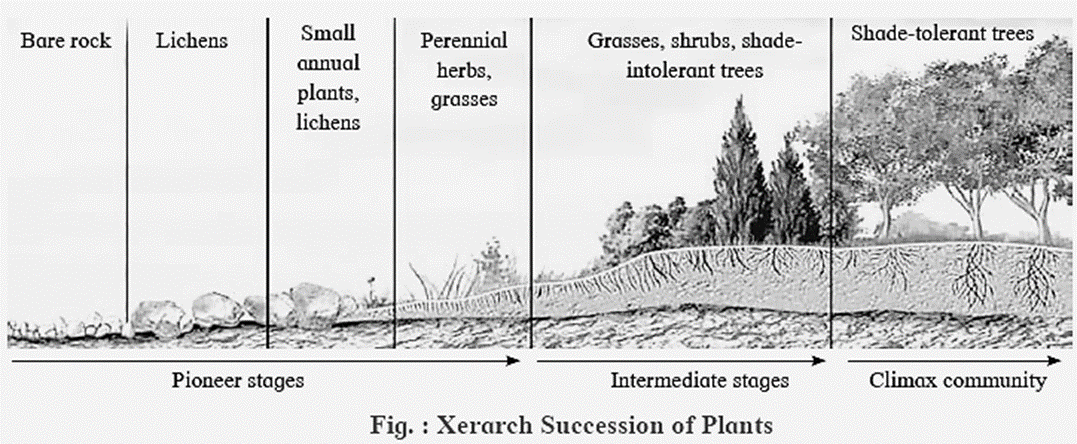
Pioneer species :
- Pioneer species are the ones that invade a bare area during primary succession.
- Crustose lichens which are able to secrete acids to dissolve rock usually start as pioneer species. They bring about weathering of rocks and soil formation.
- Later here bryophytes, mosses are settled as they can take hold in the small amount of soil. They are then followed by herbaceous plants, and after several more stages, ultimately a stable climax forest community is formed.
Ecosystem services :
Ecosystem services are the byproducts of ecosystem and processes, which include commodities and services in the fields of economics, the environment, and the crafts.
According to the definition of ecosystem services provided in the Millennium Ecosystem Assessment 2005, an ecosystem service is any advantage that a person derives from an ecosystem.
There are four types of ecosystem services : Following are the main ecological services :
Notes, Solutions, Text Book-PDF
Class 12th-Biology-Chapter-14-Ecosystems and Energy Flow-Text Book
Class 12th-Biology-Chapter-14-Ecosystems and Energy Flow- Notes
Class 12th-Biology-Chapter-14-Ecosystems and Energy Flow- Solution
PDF SET :
All Chapters Notes-Class-12-Biology-(15-PDF)-Maharashtra Board-Rs-130
All Chapters Solutions-Class-12-Biology-(15-PDF)-Maharashtra Board-Rs-128
All Chapters Notes+Solutions-Class-12-Biology-(30-PDF)-Maharashtra Board-Rs-240
Main Page : – Maharashtra Board Class 12th-Biology – All chapters notes, solutions, videos, test, pdf.
Previous Chapter : Chapter-13-Organisms and Population– Online Notes
Next Chapter : Chapter-15-Ecosystems and Energy Flow – Online Notes
We reply to valid query.